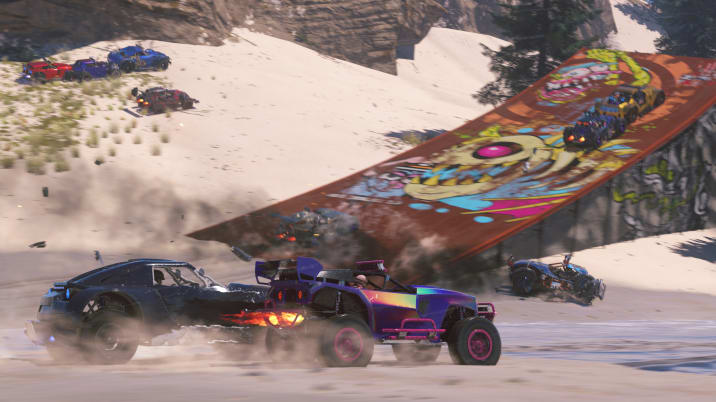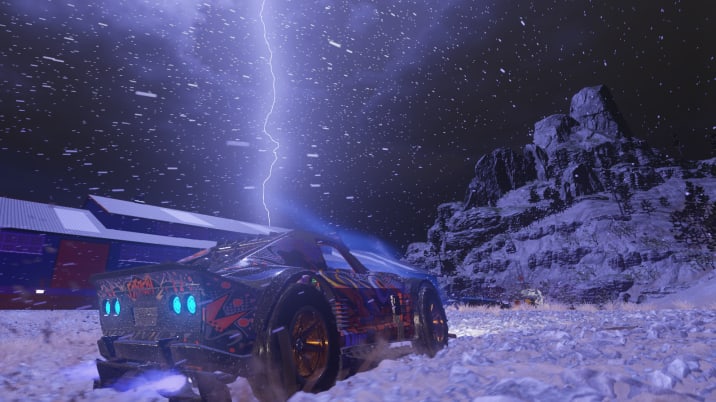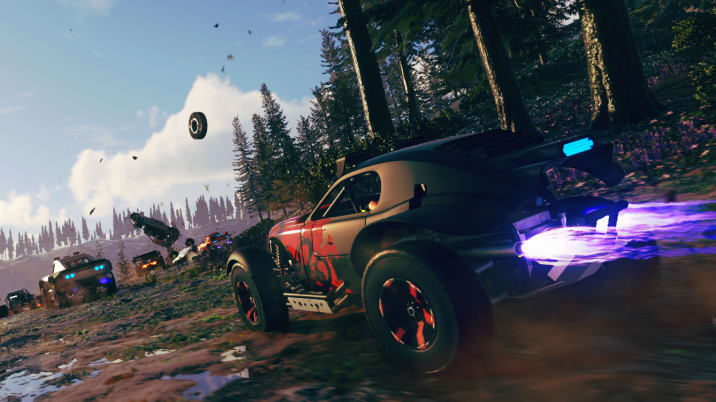
“Onrush” is a completely new driving game with no direct predecessors. It comes from publisher Codemasters, the company behind highly rated racing games including “Dirt and Grid,” and from developers from former studio Evolution Studios, the company behind off-road racing series “Motorstorm.” And although “Onrush” doesn’t have a direct predecessor, you can tell that there’s “Motorstorm” influence here. It’s another arcade-style (i.e. totally unrealistic) off-road driving game. It also features a breadth of vehicles that compete together from motorcycles to heavy trophy trucks.
But a key difference, and the reason why we’ve only referred to “Onrush” as a driving game to this point, is that there are no traditional races in the game. None of the game types reward you for finishing a certain number of laps in first position. Instead, the game features four game types that are all team-based and require variations on your driving technique. The first is “Overdrive,” which rewards the team to earn the most points, which are earned by using boost, jumping long distances, and wrecking opposing team members and “fodder” cars that appear on the course simply to be wrecked so you can earn boost and points. “Switch” is a survival mode in which every driver starts on a bike, and switches to a larger vehicle with each crash. The last team with a player that hasn’t switched to the largest vehicle wins. “Lockdown” creates a moving zone on the track where teams need to have the majority of vehicles in it to capture it. Finally, there’s “Countdown,” in which each team has a set amount of time in each round that ticks down. Gates along the track earn more time, and the first team to run out of time loses.

Admittedly, I was a little skeptical that a driving game could be completely compelling without any traditional races, but was pleasantly surprised. These different modes are all loads of fun to play, and they reward different driving styles. For instance, Overdrive encourages driving as fast and aggressively as possible at all times to earn points. Switch encourages driving carefully and defensively at the start, and then changes over to targeted aggression when you have a larger vehicle and need to take out opponents with leftover switches. Lockdown is more about playing defense and maintaining your position, rather than driving fast, and Countdown is more about simple speed and less about aggression. Of course, since it’s a team-based game, you can pick other roles in each mode, too. For instance in Countdown, you could hypothetically focus on taking out opponents to keep them from hitting gates, rather than taking on the role of going through gates yourself. There’s a lot of variety here to keep things interesting, even within the same game modes.
Supporting the varied driving types are some of the tightest driving controls we’ve experienced in a while. Every car and bike is ultra-responsive on course, making it easy to maneuver them at high-speed through the courses to hit your marks. The controls themselves are extremely simple, too. Each vehicle has special abilities, but they all activate pretty much automatically. All you have to do is manage the throttle, brakes, steering, boost, and hand brake buttons.
And you can also tell differences between the different vehicle types. Bikes and smaller buggies are really fast and nimble, almost twitchy. Heavier buggies and trophy trucks have a lot of weight, so they don’t corner as sharply, and they feel slower, but they’re also much more stable. They’re also much stronger and resistant to being wrecked. These different driving characteristics are matched with various special abilities that allow you to earn boost more quickly, slow down opponents, and more easily wreck competitors. Like the game types, these different vehicles provide plenty of variety and re-playability.

The tracks and graphics complete the gameplay package. There are loads of courses to pick from, and they all are very different from a visual perspective. You’ll race through deserts, forests, mountains and industrial locations. Every track is very wide and packed with giant jumps to make the most of the fast vehicles. Though some of the environments look a tad barren at times because of the wide open areas, they’re mostly pleasing to look at. The weather effects in particular are stunning. I was most wowed by a winter course that takes place during a thunderous snow storm. The snow falls thick and reflects off the headlights obscuring what’s ahead and demanding lightning-quick reflexes. All the while you see lightning that flashes, briefly illuminating the way. All the time, the framerate stays extremely quick and smooth, enhancing the feeling of speed. And this should be the case on most systems, since we tested the game on a standard Playstation 4, not a Playstation 4 Pro.
Beyond just gameplay, “Onrush” features a fairly robust offline campaign mode that strings together many events and restricts your vehicle type to keep challenges fresh. The early events are almost laughably easy, but the difficulty does begin to ramp up a bit as the campaign continues. Online multiplayer events are a big part of the game, and they play just as quick and fun as offline events, but they tend to be closer and more tense as teams trade rounds back and forth. Another plus is that it doesn’t take long for multiplayer events to load, so you shouldn’t spend much more time waiting between events than actually competing.

If we had any complaints, one would be the slightly shallow customization. Every vehicle can be equipped with different body shells and paint schemes, and the preset drivers can have different outfits, but you can’t tweak them anymore than just switching them. There are no custom paint job editors, and body shells can’t be fitted with different parts. Another issue is that new items are rewarded in random prize crates, so you can’t easily pick a specific part to unlock if you want it. And while our time with the game showed no evidence of microtransactions for buying additional prize crates, it probably wouldn’t be hard to implement. Also, if we’re being really nitpicky, the cars don’t crumple as satisfyingly as they do in games such as “Burnout Paradise.”
All things considered, though, “Onrush” is exactly the fast-paced arcade game we were hoping for. It delivers fun driving and good re-playability for both offline and online players, and it looks great in action. We definitely recommend taking it for a spin. Now if you’ll excuse us, we have more buggies to jump and smash.